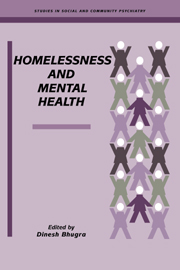Book contents
- Frontmatter
- Contents
- List of contributors
- Preface
- Part I INTRODCTION AND SPECIAL GROUPS
- Part II SERVICES
- 7 Services for the mentally ill homeless
- 8 Clinical work with homeless people in the USA
- 9 The severely mentally ill in hostels for the homeless
- 10 Old and homeless in London and New York City: a cross-national comparison
- 11 Primary health care of the single homeless
- Part III INTERNATIONAL PERSPECTIVE
- Part IV POLICY AND EVALUATION
- Index
11 - Primary health care of the single homeless
from Part II - SERVICES
Published online by Cambridge University Press: 15 October 2009
- Frontmatter
- Contents
- List of contributors
- Preface
- Part I INTRODCTION AND SPECIAL GROUPS
- Part II SERVICES
- 7 Services for the mentally ill homeless
- 8 Clinical work with homeless people in the USA
- 9 The severely mentally ill in hostels for the homeless
- 10 Old and homeless in London and New York City: a cross-national comparison
- 11 Primary health care of the single homeless
- Part III INTERNATIONAL PERSPECTIVE
- Part IV POLICY AND EVALUATION
- Index
Summary
To write about the primary care of the single homeless suggests that there are particular factors in that population that are in some way different to the general population, and that these influence care. It is important to understand these factors if we are to look at primary care in this setting. To start with, who exactly do we mean and can we define the population? This is far from straightforward but definitions should include inadequate accommodation and some degree of disaffiliation from society. ‘Single’ homeless usually means those who are unmarried or divorced and without close supportive relationships, but occasionally married couples are seen within groups considered to be single homeless. In this chapter, we will look at the care of a wide and disparate population, living on the streets, in hostels, night shelters and bed and breakfast accommodation, as well as those in more permanent accommodation but who have previously had more tenuous accommodation.
A morbidity profile
A number of studies have described the physical and psychiatric morbidity of a variety of single homeless populations. In terms of physical health, frequent infectious, respiratory and skin diseases and infestations are usually described, along with trauma (Hewetson,1975; Powell, 1987; Shanks, 1988). Within this perhaps obvious pattern are more serious diseases, less prevalent in the general population. Tuberculosis is the best known (Patel, 1985) although others such as epilepsy are found more frequently than expected. Over 50% of hostel populations are usually found to suffer from a chronic disease (Scott et al, 1966). Studies of psychiatric disorders show wide variations, schizophrenia is common and its prevalence has been estimated in one study as over 40% (Weller et al, 1989).
- Type
- Chapter
- Information
- Homelessness and Mental Health , pp. 170 - 184Publisher: Cambridge University PressPrint publication year: 1996
- 1
- Cited by



